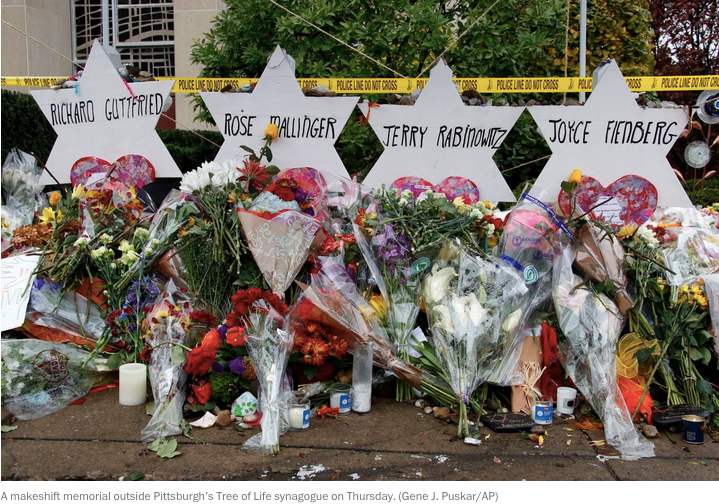Melissa Fay Greene is the author of “The Temple Bombing,” about the 1958 bombing of the Hebrew Benevolent Congregation in Atlanta, and other books.
“At exactly fifteen minutes past eight in the morning, on August 6, 1945, Japanese time, at the moment when the atomic bomb flashed above Hiroshima, Miss Toshiko Sasaki, a clerk in the personnel department of the East Asia Tin Works, had just sat down at her place in the plant office and was turning her head to speak to the girl at the next desk.” So begins John Hersey’s “Hiroshima,” revealing how a sudden strobe light of unthinkable violence illuminates and freezes for all time the everyday motions of people caught in the glare.
Although there’s no comparison in scale, I thought of Hersey’s book as the news of the Tree of Life synagogue massacre broke over us, wave after wave of ever-more-specific details. The accumulating minutiae did not paint grander and more cinematic images of the events; quite the opposite — they brought into focus scenes ever more modest and homely: someone waited just inside the shul door to hand out prayer books to arriving worshipers; a small table stood ready with wine cups for the celebration of a bris; people looked forward to having a bite to eat together at a kiddush luncheon of challah, cheese, tuna salad and cookies. The emerging particulars gave us, among others, a retired accountant who loved the Pirates, a long-married elderly couple, a pair of developmentally delayed middle-aged brothers, a sprightly little lady closing in on her 100th birthday, and a 71-year-old man whose 1-year-old grandson was “the love of his life.” The social hall was mentioned. A storage room played a role.
The Jewish people know from social halls. I spent more of my childhood synagogue hours in the noisy basement linoleum-floored social hall under fluorescent lights than in the softly lit, carpeted sanctuary upstairs. The Purim carnival, the Hanukkah play, the bar mitzvah parties, the Shabbat luncheons of egg salad and rye bread and herring on paper plates at folding tables, with the kitchen in back and the mimeograph machine on a rolling cart in an adjacent storage closet. Synagogues, churches and mosques must all have these closets — windowless, narrow and tall, and lined with metal shelves up to the ceiling containing enough reams of paper in many colors for a decade’s worth of brochures.
Congregants were slaughtered in the social hall. Three of the Pittsburgh survivors hid out in the storage closet, while an elderly fourth also sheltering in there — perhaps confused — opened the door too soon and was murdered.
Even before the names of the victims were released — the number of dead clicking upward as hours passed — we knew who they would be. The first arrivals for Shabbat services tend to be the middle-aged and the elderly; at that hour, younger households are still corralling the children, trying to find the other shoe or the matching sock. The early birds tend to be the shomrim, the guardians of the congregation, the folks who — thanks to a long-ago yeshiva education — lead the morning service. As the terrible list of the dead was released, our hunch was proved correct: The early-arriving regulars had been mowed down. “The heart of our congregation,” said a fellow member. “They are the people who conducted our services, they did Torah readings, they managed the bimah.”




